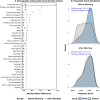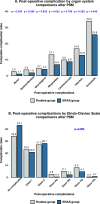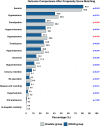Effectiveness of an Enhanced Recovery After Surgery (ERAS) Program in Hip Arthroplasty in a Developing Country: A Propensity Score-Matched Study from Vietnam
- PMID: 40395275
- PMCID: PMC12091245
- DOI: 10.2147/JMDH.S521828
Effectiveness of an Enhanced Recovery After Surgery (ERAS) Program in Hip Arthroplasty in a Developing Country: A Propensity Score-Matched Study from Vietnam
Abstract
Background: Delayed recovery and adverse outcomes frequently follow hip arthroplasty, often due to comorbidities in elderly patients and the invasive nature of the surgery. Although Enhanced Recovery After Surgery (ERAS) programs are widely recommended in developed nations, their effectiveness in developing countries remains under-researched.
Objective: This study aims to evaluate the effectiveness of the ERAS program in improving outcomes for patients undergoing hip arthroplasty.
Patients and methods: This retrospective observational study was conducted at a single university medical center. Propensity score matching was employed to ensure comparability between the ERAS and routine care groups. The primary outcome measured was the post-operative length of stay. Secondary outcomes focused on rates of complications. Tertiary outcomes included other clinical events and symptoms.
Results: The study initially enrolled 769 participants and retained 548 after matching. In the primary outcome, the ERAS group had a shorter length of stay, with a median of 6.1 compared to 7.0 days (Hodges-Lehmann estimate of 0.9 days, 95% confidence interval of 0.2 to 1.0 days, p<0.001). In secondary outcomes, the ERAS group showed lower incidences of composite complications (25.6% vs 33.6%, p=0.040) and respiratory complications (6.9% vs 13.1%, p=0.023). In tertiary outcomes, the ERAS group had lower rates of constipation (27.0% vs 38.3%, p=0.006) and perioperative hyponatremia (21.5% vs 29.6%, p=0.040). No statistically significant differences were observed in the remaining outcomes.
Conclusion: The ERAS program improved patient outcomes by reducing length of stay and complications for those undergoing hip arthroplasty in our country. Therefore, this study confirms the effectiveness of ERAS programs and advocates for their broader implementation in similar healthcare settings.
Keywords: complications; healthcare burdens; hip arthroplasty; length of stays; propensity score matching.
© 2025 Vu et al.
Conflict of interest statement
All authors report no conflicts of interest in this work.
Figures







Similar articles
-
Propensity score-matched analysis of enhanced recovery after surgery in total hip arthroplasty for displaced femoral neck fractures.Injury. 2023 Dec;54(12):111132. doi: 10.1016/j.injury.2023.111132. Epub 2023 Oct 15. Injury. 2023. PMID: 37883840
-
Association Between Use of Enhanced Recovery After Surgery Protocol and Postoperative Complications in Total Hip and Knee Arthroplasty in the Postoperative Outcomes Within Enhanced Recovery After Surgery Protocol in Elective Total Hip and Knee Arthroplasty Study (POWER2).JAMA Surg. 2020 Apr 1;155(4):e196024. doi: 10.1001/jamasurg.2019.6024. Epub 2020 Apr 15. JAMA Surg. 2020. PMID: 32049352 Free PMC article.
-
Effectiveness of the enhanced recovery after surgery (ERAS) program after lobectomy for lung cancer: a single-center observational study using propensity score matching in Vietnam.J Thorac Dis. 2024 Nov 30;16(11):7686-7696. doi: 10.21037/jtd-24-1053. Epub 2024 Nov 12. J Thorac Dis. 2024. PMID: 39678898 Free PMC article.
-
Enhanced recovery after surgery in patients after hip and knee arthroplasty: a systematic review and meta-analysis.Postgrad Med J. 2024 Feb 15;100(1181):159-173. doi: 10.1093/postmj/qgad125. Postgrad Med J. 2024. PMID: 38134323
-
[Interest of enhanced recovery programs in the elderly during total hip arthroplasty A systematic review].Geriatr Psychol Neuropsychiatr Vieil. 2019 Sep 1;17(3):234-242. doi: 10.1684/pnv.2019.0796. Geriatr Psychol Neuropsychiatr Vieil. 2019. PMID: 31251213 French.
References
-
- Al-Worafi YM. Quality of healthcare systems in developing countries: status and future recommendations. In: Handbook of Medical and Health Sciences in Developing Countries: Education, Practice, and Research. Springer; 2023:1–28.
LinkOut - more resources
Full Text Sources

